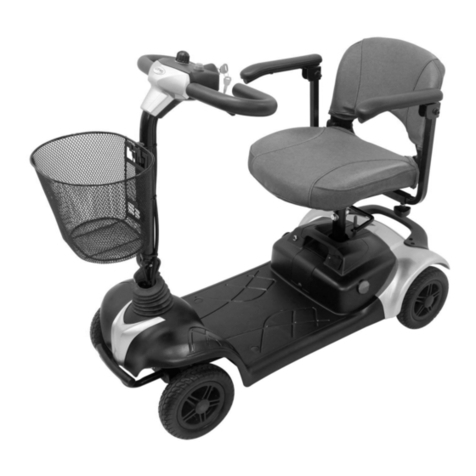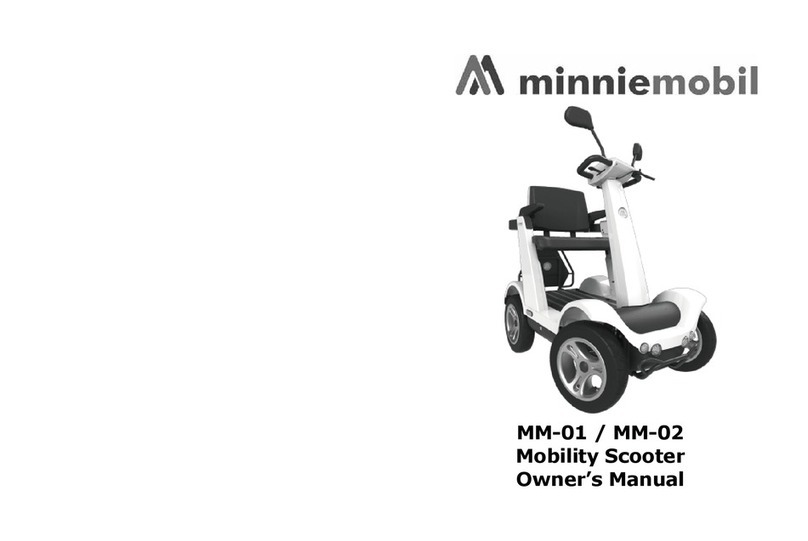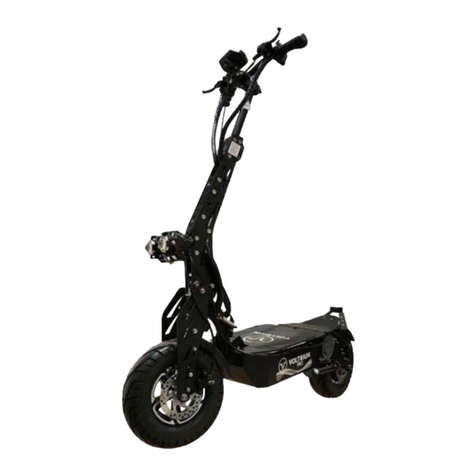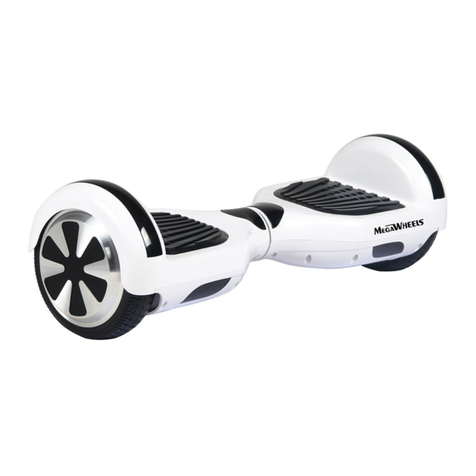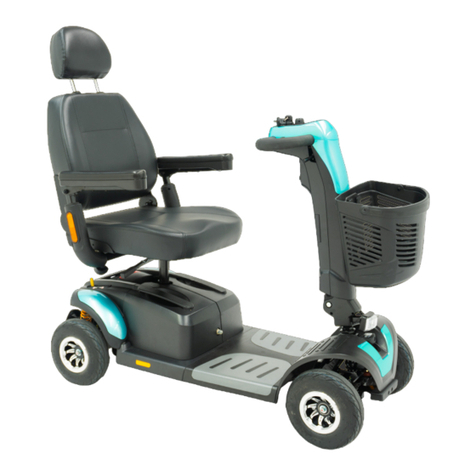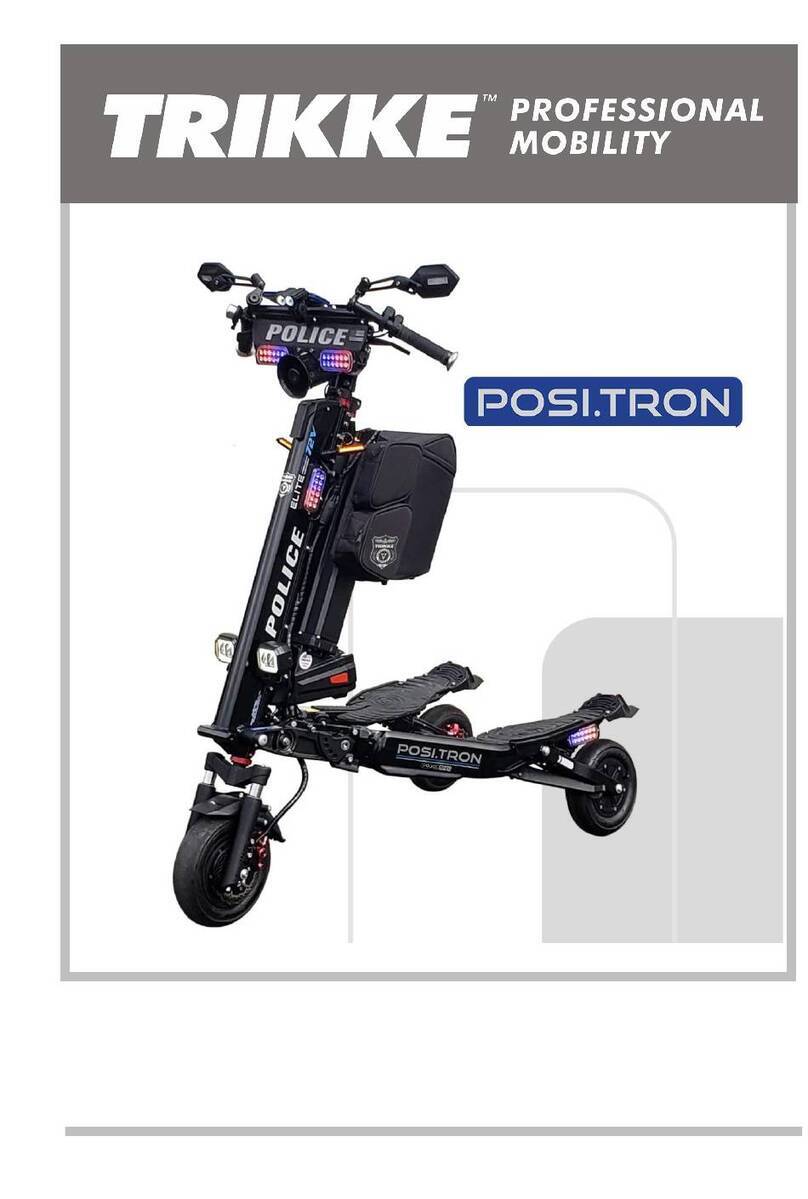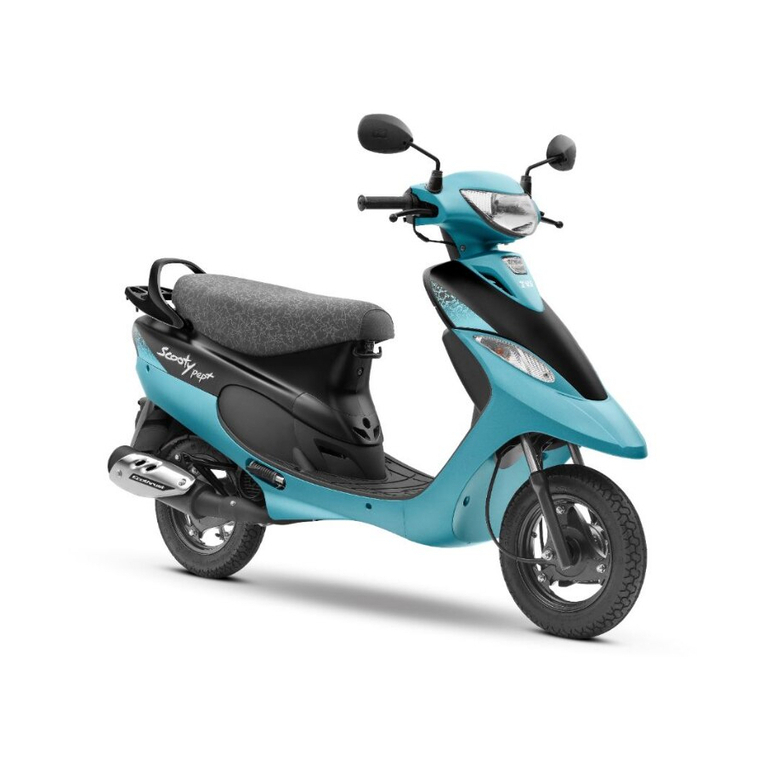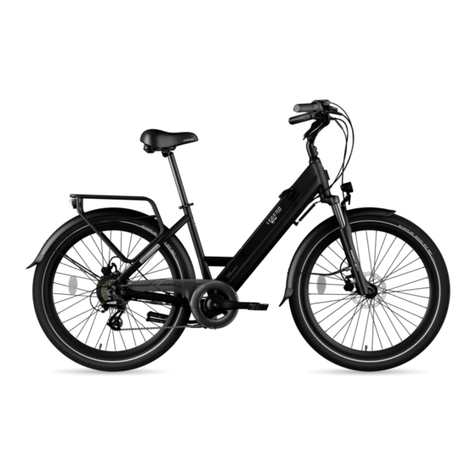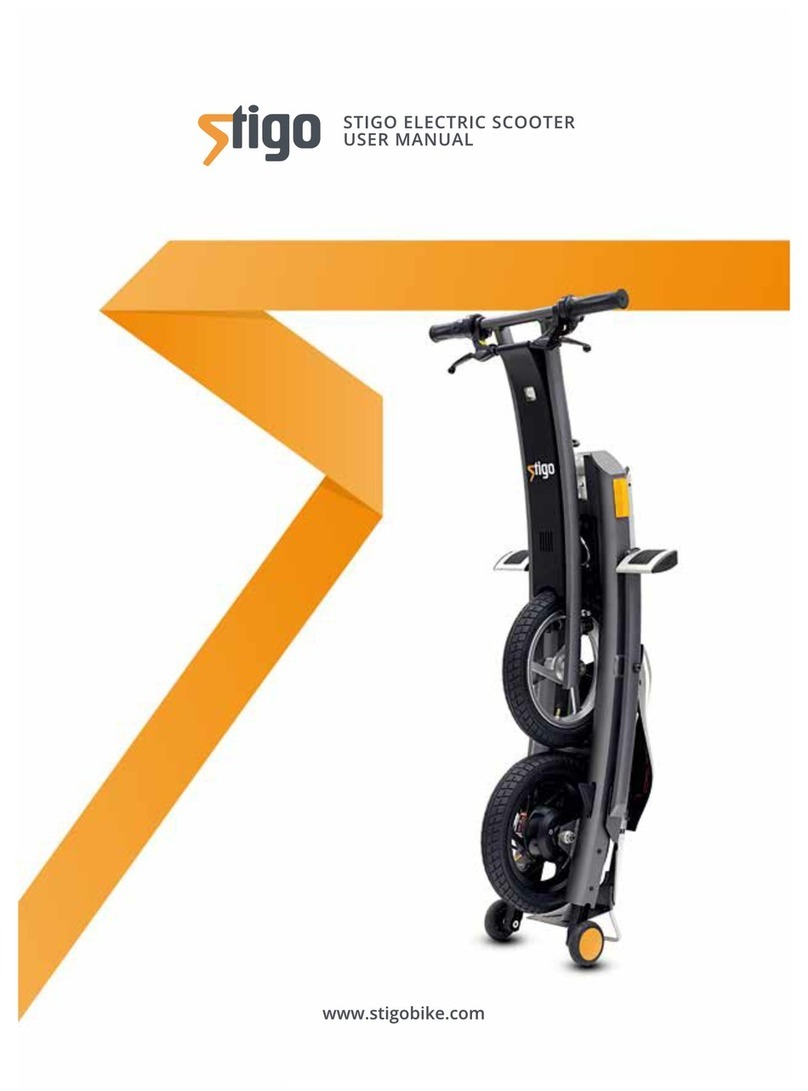Medema Mobility Scooter User manual

User Manual
Mini Crosser M1
P9-0155-B ver. 2.0.4 - July 2012 GB
medemagroup
U
ser Manual
M
ini
C
rosser M
1
m
e
d
ema
gr
oup

User guide P9-0155-B 2 of 52 Version 2.0.4/2012
Medema Production A/S
Serial number: ___-______________-______-_______
Delivery date: ________________ Year 20______
This vehicle was supplied by: Date: /

User guide P9-0155-B 3 of 52 Version 2.0.4/2012
Medema Production A/S
Contents
Symbols.................................................................................. 4
Warning!................................................................................. 4
Contagion!.............................................................................. 4
Introduction............................................................................ 5
Declaration of conformity..................................................... 6
Control panel ......................................................................... 7
Preparations / Adjustments prior to use............................. 9
Electric seat adjustment....................................................... 10
Seat rotation........................................................................... 11
Steering column .................................................................... 12
Serial number......................................................................... 13
Driving the Mini Crosser M1................................................. 14
Specific driving situations.................................................... 20
Long hills/difficult ground.................................................... 22
Anti-tilt wheels / stabilisers.................................................. 23
General care and maintenance ............................................ 24
Insurance................................................................................ 25
Batteries................................................................................. 26
Charging................................................................................. 26
Battery disposal..................................................................... 28
Storage................................................................................... 28
Cleaning ................................................................................. 28
Changing the wheels............................................................. 29
Fuses...................................................................................... 30
Brakes..................................................................................... 31
Disengagement...................................................................... 32
Transporting by motor vehicle............................................. 33
Securing to vehicle floor with belts..................................... 34
Transporting by plane........................................................... 37
Towing.................................................................................... 37
Dimensioned drawing, Mini Crosser M13W........................ 38
Dimensioned drawing, Mini Crosser M14W........................ 39
Introduction to seats - Ergo Standard................................. 40
Introduction to seats - Mando.............................................. 42
Troubleshooting .................................................................... 43
Programming......................................................................... 46
Technical data........................................................................ 46
Own notes.............................................................................. 49
International addresses........................................................ 50

User guide P9-0155-B 4 of 52 Version 2.0.4/2012
Medema Production A/S
Symbols
Used in the manual to indicate sections describing situations
where extra care is required owing to the risk of personal injury.
Used to indicate sections on electromagnetic compatibility
(EMC).
Warning!
For safety reasons the vehicle must not be lent to persons who
are not completely familiar with it. The vehicle is designed for
one person only.
The Mini Crosser M1has been designed for users weighing
max. 175 kg. Can be supplied in a HD version as standard for a
max person weight of 250 kg.
Contagion!
Note!
The tires can sometimes rub off on floor coverings, particularly
linoleum. Medema Production assumes no responsibility in
case of contagion.
To prevent this, we recommend that you protect delicate floors
with some sort of driving surface.

User guide P9-0155-B 5 of 52 Version 2.0.4/2012
Medema Production A/S
Introduction
Congratulations on your new Mini Crosser M
1
electric mobility scooter.
You have now taken possession of an electric mobility scooter
developed for outdoor driving by active users. It is what is
called a Class C vehicle in accordance with the European
classification of electric scooters.
For optimum enjoyment of this vehicle - and to avoid
breakdowns and accidents - we recommend that you read this
User Manual carefully. As a new user, you should pay particular
attention to the section entitled “Driving the Mini Crosser M1”.
The Mini Crosser M
1
is designed for safe travel for at least 10 years,
up to a max. of 5,000 hours, provided it is serviced and safety-
checked every year, corresponding to 500 hours of operation. The
service must be carried out by an authorised workshop.
IMPORTANT! For safety reasons it is of the utmost importance
that service and safety check intervals are complied with, as
this minimises the risk of brake failure and short-circuits in the
wiring, which could generate heat and cause a fire.
We offer a wide range of accessories for the Mini Crosser M1
that can make everyday life easier for you. You are always
welcome to contact us for further information on special
accessories and adaptations.
Medema Production A/S is not responsible for any damage or injuries
caused by inappropriate or unsafe use of the Mini Crosser M
1
.
If you have any further questions about the Mini Crosser M1or
this User Manual, you are always welcome to get in touch. Our
contact details are as follows:
Medema Production A/S
Tel: +45 7010 2054
Email: info@minicrosser.com
Internet: www.medema.com
NB: Errors and omissions excepted. We reserve the right to
update this manual as required.

User guide P9-0155-B 6 of 52 Version 2.0.4/2012
Medema Production A/S
Declaration of conformity
Medema Production A/S hereby declares that:
Machine: Mini Crosser
Use: (Prescribed use in
User Manual)
Model No: M1
Complies with the Medical Device Directive 93/42/EEC
The product is made in accordance with the harmonized
standard EN 12184 - Electrically powered wheelchairs, scooters
and their chargers.
The product is risk analysed in accordance with the harmonized
standard DS/EN ISO 14971:2007-04-10 2. edition - Medical
devices - Application of risk management to medical devices.
The Mini Crosser can, for a fee, be taken to the nearest
dealer for disposal in accordance with current environmental
regulations.
Manufacturer: Medema Production A/S
Address: Enggårdvej 7, DK-7400 Herning
Tel./Fax +45 7010 2054 +45 9716 8582
Date: 12.04.2010 Signature: _____________________

User guide P9-0155-B 7 of 52 Version 2.0.4/2012
Medema Production A/S
Control panel
Avoid subjecting the control panel to jarring and knocks. Take
care when driving and avoid hitting obstacles.
The manufacturer accepts no liability in respect of the
unauthorised opening, adjustment or modification of the control
panel.
Lever for adjusting the angle of the
handlebars
Charging socket
Key switch
Indicator lights, R/L
Horn
Accelerator
(four-finger control)
Indicator lights,
R/L
Horn
Speed selector
Hazard warning lights
Battery indicator
Handbrake
Light switch

User guide P9-0155-B 8 of 52 Version 2.0.4/2012
Medema Production A/S
Designation Description
Key switch To start the vehicle:
Turn the key to driving position (1) When the Mini Crosser
is turned on, the control system performs a safety check of
the electrical system. The check lasts half a second. If the
accelerator is operated during this time, the Mini Crosser will not
be able to move until you have turned the key to 0 and back to 1.
Speed selector The tortoise in minimum position indicates the lowest speed
range. 0-6 km/h
The hare in maximum position indicates the highest speed
range. Up to 15 km/h
Battery indicator Lights up when the key is turned. Indicates, after half a
second, the battery charge level. It gives a more precise
indication after approx. 1 minute of driving. When the red,
amber and green sections are lit, the batteries are fully
charged. When the indicator is at the bottom of the amber
section, the batteries should be charged as soon as possible.
If only the red section is lit or flashing, the batteries must be
charged immediately.
Handbrake Acts on the rear wheel and should only be used as an extra
/emergency brake and parking brake. It can be secured in
locked position. Also available as a foot brake.
Accelerator
(See picture
below)
Activate the arm at the front slowly and the Mini Crosser will
start to move forwards. The more the arm is pressed, the faster
the Mini Crosser will move. When the arm is released, it will flip
back to starting position of its own accord and the Mini Crosser
will stop. Activating the rear arm will cause the Mini Crosser to
reverse. The magnetic brake on the rear wheels will engage
when the scooter is stationary and is equivalent to the parking
brake on a car. The accelerator can also be used to control
speed downhill. In this case the motor will act as a brake.
Light switch Turns on the front and rear lights. The key switch must be in
position 1 (driving position).
Hazard warning
lights Turns on all the indicator lights at once. Also works when the
key is removed or turned to position 0 (stop position).
Indicator switch
Left arrow: indicator, left-hand side. Right arrow: indicator, right-
hand side. Activate the same switch to turn the indicators off.
Horn Powerful electric horn. Press the horn switch to activate.
Charging socket Turn off the key switch during charging. Please note that it is
not possible to drive the scooter while the batteries are char-
ging. See also the section entitled “Batteries and charging”.
Accelerator
(four-finger control)

User guide P9-0155-B 9 of 52 Version 2.0.4/2012
Medema Production A/S
Preparations / Adjustments prior to use
Adjusting the height of the seat
Lift the seat off and remove the rear cover. Pull the release out
and adjust the seat tube to the desired position. See the picture
on the next page. Check that the seat height is correct and let
go of the release. Move the seat tube up/down until the release
clicks into a hole.
Make sure you keep your back straight when lifting the seat,
which is very heavy. (See below.)
Lift the seat off the seat tube.
The release button pressed in. Press the
button out to release the seat tube. Release button pressed out. Now the
seat tube can be moved up/down to
the height you wish. Press the release
button again and make sure it is fitted in
one of the 5 holes in the seat tube.

User guide P9-0155-B 10 of 52 Version 2.0.4/2012
Medema Production A/S
Seat tube in top position. There are five
holes for adjusting the seat tube. The
release must be in a hole for the seat to
be stable.
Electric seat adjustment
The Mini Crosser can be fitted with electric seat adjustment as
an optional extra.
To raise the seat, press the switch up. To lower the seat, press
the switch down. If the switch is released, the seat will stop
automatically. (See figure below.)
Electric seat adjustment. If the switch is pressed up, the seat
is raised. If the switch is pressed down, the seat is lowered.
Switch for electric
seat adjustment
Seat tube
Release

User guide P9-0155-B 11 of 52 Version 2.0.4/2012
Medema Production A/S
Seat rotation
Pull the release lever back. The seat can be rotated 90° to
either side. When the lever is released, it engages with the seat
and holds it in place at 45° intervals.
Other seats that can be supplied for the Mini Crosser work on
similar principles. The release lever is normally mounted on the
right, but can be put on the left if so wished.
IMPORTANT!
The Mini Crosser is most stable when the seat is in its lowest
position. Always drive carefully when the seat is raised. Never
use the seat adjustment when driving on an uneven surface or
in hilly terrain.
Take extra care when lowering the seat on a Mini Crosser using
electric seat adjustment. Make sure that nothing is trapped in
the space between the seat and the chassis.
Avoid trapping anything when lowering the seat.
Release lever for seat rotation. Release lever for seat forward/back.

User guide P9-0155-B 12 of 52 Version 2.0.4/2012
Medema Production A/S
Steering column
Can be adjusted forward/back with the release lever. Pull down
on the lever and pull the handlebars closer for a good driving
position. Use the lever again and push the steering column
forward to make it easier to get out.
The height of the steering column can be adjusted approx. 11
cm up/down. First remove the rubber plug covering the Allen
screw. Adjust the height using a 4 mm Allen key.
This applies to both the 3W and the 4W model. Remember to
retighten properly after adjusting.
Adjusting the angle of
the handlebars. Applies
to both the 3W and the
4W model.
Lever for adjusting the angle of
the handlebars
Adjusting the height of
the handlebars. Applies
to both the 3W and the
4W model.
Allen screw for height
adjustment

User guide P9-0155-B 13 of 52 Version 2.0.4/2012
Medema Production A/S
Serial number
All vehicles have a serial number plate showing the year of
production and serial number. The same serial number can also
be found on the front of the User Manual.
Please quote this number when making inquiries about
servicing, spare parts, etc.
Maximum user weight
Vehicle’s unladen weight inc.
batteries and seat
Position of serial number plate on vehicle.
Serial number
Model description
Year of production Max. speed

User guide P9-0155-B 14 of 52 Version 2.0.4/2012
Medema Production A/S
Driving the Mini Crosser M1
Getting in and out
It is important to learn a safe technique for getting in and out of
the Mini Crosser.
In general the following method should be followed:
• Make sure that the Mini Crosser M1is off (switch turned to 0)
when getting in and out, otherwise the Mini Crosser could start if
the accelerator was touched inadvertently.
• Make sure that the brake is on. (Lever for disengaging motor in
top position.)
• Put the steering column in vertical position.
• If necessary, turn the seat through 45° or 90° and make sure that
it is locked in position (clicked into place).
• If necessary, raise the armrest.
For some users the assistance of an attendant can be
recommended. The attendant should:
• Take care not to injure him/herself when lifting/lowering/supporting
the user.
• Make sure that the Mini Crosser is stable and unable to move.
Turn off the Mini Crosser and check that the brake is on and the
seat has been rotated until it clicks into place at either 45° or 90°.
• Make sure that the seat the user is being moved to is stable.
Turn the Mini Crosser off, return the
steering column to upright position, rotate
the seat and raise the armrest.
IMPORTANT!
The Mini Crosser will turn
itself off automatically after
it has been stationary for
10 minutes even if the key
has been turned to driving
position.
To restart the vehicle, the
key must be turned to stop
position (0) and then to driving
position (1).

User guide P9-0155-B 15 of 52 Version 2.0.4/2012
Medema Production A/S
Braking systems
There are three braking systems on the Mini Crosser:
• Motor brake - adjusts vehicle speed also when going downhill.
• Magnetic brake - the magnetic brake is automatic and
engages when the Mini Crosser stops. In an emergency,
the Mini Crosser can be stopped instantaneously by turning
the key switch. Please note that this will cause very sharp
braking. The rear wheels will lock.
Must NOT be used in the normal course of driving.
The brake must never be disengaged mechanically using
the disengagement lever on a slope. This function is only
designed for use when pushing the Mini Crosser on a flat
road.
• Electric safety brake - if the brake is somehow disengaged on
a slope/hill, the Mini Crosser will brake automatically when it
reaches a certain speed. There is an electric safety feature in the
control system, which works even if the battery is disconnected.
This is also the reason why the Mini Crosser cannot be towed at
more than 5 km/h. See the section about towing.
• Handbrake - intended as an emergency brake and parking
brake. It must be operated with caution when driving in
slippery conditions and downhill.
General safety advice
Make sure that the backrest is upright and the seat is as low as
possible.
Positioning belts are recommended if the user is unable to
maintain a good driving posture independently.
When using the handbrake as a parking
brake, lock it in braking position by
pressing the button in while applying the
brake.
To release the brake, press the button
again.
Handbrake lock

User guide P9-0155-B 16 of 52 Version 2.0.4/2012
Medema Production A/S
Adjust your driving to road conditions. Take account of light,
traffic and weather. Be particularly careful when driving in the
dark or in bad weather, such as rain or snow. Avoid driving on
gradients with poor surfaces, such as: snow, ice, new-mown
grass, wet grass and wet leaves.
Never drive when under the influence. This applies not only to
alcohol, but also to drugs and medicines.
Reduce speed immediately if you feel you are losing control.
Always use the indicators when changing direction.
Check that lights and indicators are working before driving off.
Use your lights when driving after lighting-up time.
As far as possible, grip the handlebars firmly with both hands.
Take care not to have anything in the basket at the front that
might inadvertently operate the accelerator.
WARNING! Do not lower the handlebars so far that the
accelerator can hit you on the leg when you turn the vehicle and
so be operated in advertently. If the handlebars need to be very
low, a twist grip accelerator is recommended. This is particularly
relevant if leg supports are being used.
ALWAYS switch the scooter off when it is not in use. Turn the
key to 0.
Driving
Even though the Mini Crosser is very stable, it can tip over.
Avoid sudden changes of speed and direction when travelling at
high speed, on poor surfaces and, not least, on slopes.
For short distances the Mini Crosser can drive up steeper
gradients than it has been tested as dynamically stable for. The
same applies to driving down such gradients. In such cases
there is an increased risk of the Mini Crosser tilting and even
tipping over. So be extra careful in following the driving tips
given below.

User guide P9-0155-B 17 of 52 Version 2.0.4/2012
Medema Production A/S
Anti-tilt wheels are recommended for driving in very hilly terrain.
(Optional extra)
New users are urged to practise the following in an area where
there is no other traffic:
• Set the Mini Crosser to low speed. Drive forwards and backwards.
Gradually turn the speed selector up and feel the change in the
speed of the Mini Crosser.
• Practise starting and braking. Get used to the Mini Crosser’s
response time.
• Practise driving in a narrow space, similar to inside a shop or
through a door.
• Practise turning, and get a sense of how much space is required.
Always drive slowly when turning. Practise reversing too.
• Practise cornering and driving over obstacles and on slopes.
Always drive straight up/down kerbs and ramps. Never at an
angle. See the illustrations on the following pages.
• Try braking at different speeds and notice the stopping distances.
• If possible, try driving on different surfaces (road, grass and
gravel).
• Practise assessing how far you can drive on a single battery
charge. Note how quickly the battery indicator changes from
green to amber to red.
Note!
The driving distance of the scooter will be reduced when driving
in hilly districts, into a head wind, in cold weather and with low
tyre pressure.
Traffic regulations
The traffic legislation for scooters varies from country to
country. Before starting to use the vehicle outdoors, it is the
user’s responsibility to familiarise him/herself with the relevant
legislation.

User guide P9-0155-B 18 of 52 Version 2.0.4/2012
Medema Production A/S
The following rules apply in Denmark:
Mobility vehicles such as the Mini Crosser with a maximum
speed of up to 15 km/h count as cycles in traffic legislation and
the traffic regulations for cycles must be followed at speeds in
excess of 6 km/h.
At speeds of up to 6 km/h the Mini Crosser is regarded as a
“pedestrian”, and it is permissible to travel on the pavement at
this speed. “Tortoise” speed corresponds to approx. 6 km/h.
Lights must only be used during lighting-up time. Crash helmet
and seat belts are not compulsory.

User guide P9-0155-B 19 of 52 Version 2.0.4/2012
Medema Production A/S
Electromagnetic compatibility
If the Mini Crosser starts making involuntary movements or if
the brakes are released, turn the Mini Crosser off as soon as it
is safe to do so. In certain circumstances a Mini Crosser can set
off shop alarms.
The Mini Crosser satisfies the requirements for the use of
scooters in an environment with electromagnetic noise. There
may, however, be rare situations in which electromagnetic noise
can affect the Mini Crosser. Sources of such noise include radio
and television stations, amateur radio transmitters and mobile
phones.
If such equipment is being used close by, it is recommended
that the Mini Crosser is switched off. Mobile phones should not
be used while driving.
When driving in traffic...
Be particularly aware of the following when driving in traffic:
• The Mini Crosser is a low vehicle and not always easy for other
road users to see. Make quite sure that other road users have
seen you before driving onto the highway.
• Keep an eye on traffic behind you. Keep well over to the side of
the road when driving on busy roads.
• Turning right and left at crossroads. Be aware of cyclists and
pedestrians. Follow the rules of the road for cyclists.
• How quickly things are happening. How long do the lights stay
green? How quickly are cars approaching? etc.

User guide P9-0155-B 20 of 52 Version 2.0.4/2012
Medema Production A/S
Specific driving situations
Up kerbs
• Stop at right angles to the kerbstone about 5-10 cm away from it.
Keep an eye on other road users.
• Lean forwards.
• Accelerate moderately so that your vehicle can overcome the
obstacle. Do not stop halfway, but reduce speed once the vehicle
is up.
• If the kerb is too high, do not try again, but find an alternative
route.
Down kerbs
• Lean back.
• If you are driving onto a road with traffic, keep an eye on other
road users.
• Drive forwards and down the kerb at low speed. Make sure that
your anti-tilt wheels (if fitted) do not catch on the edge.
This manual suits for next models
1
Table of contents
Other Medema Scooter manuals

Medema
Medema Mini Crosser M1 User manual

Medema
Medema MC 1122 Quantum User manual
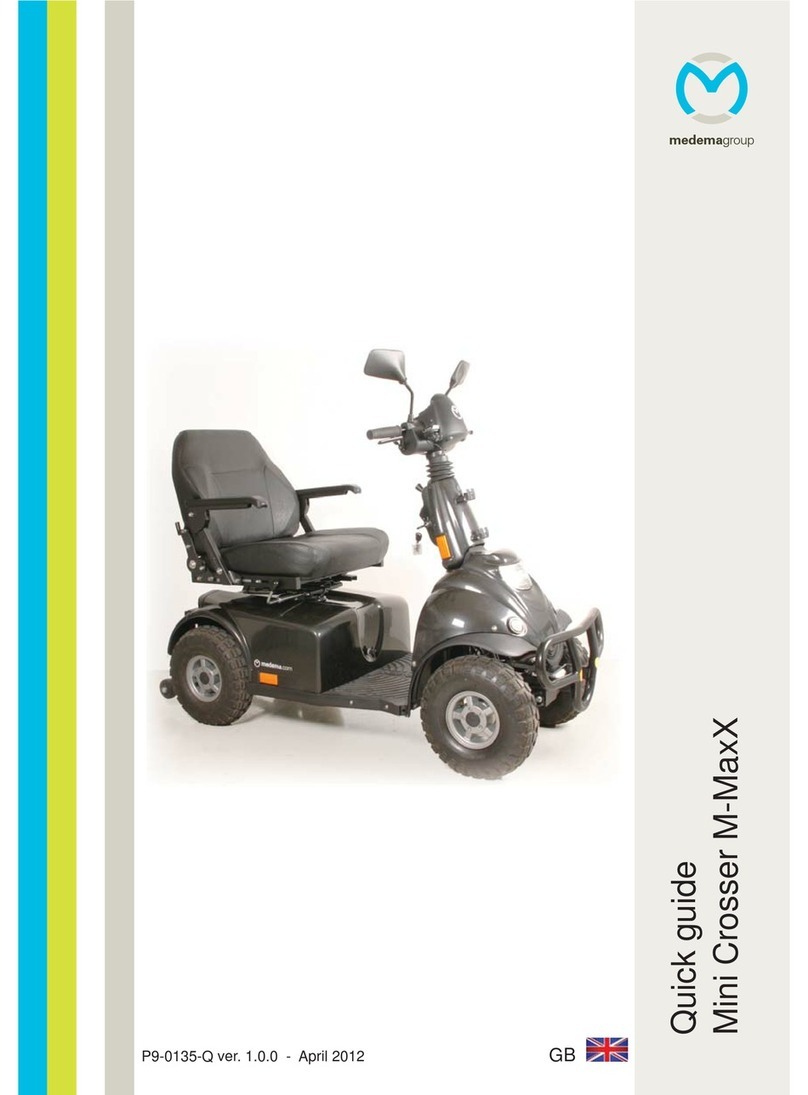
Medema
Medema Mini Crosser M-MaxX User manual
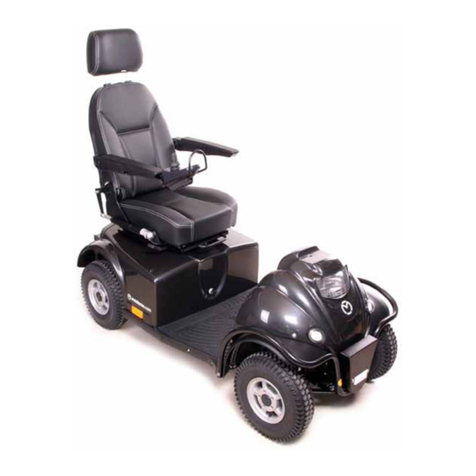
Medema
Medema M1 joy User manual
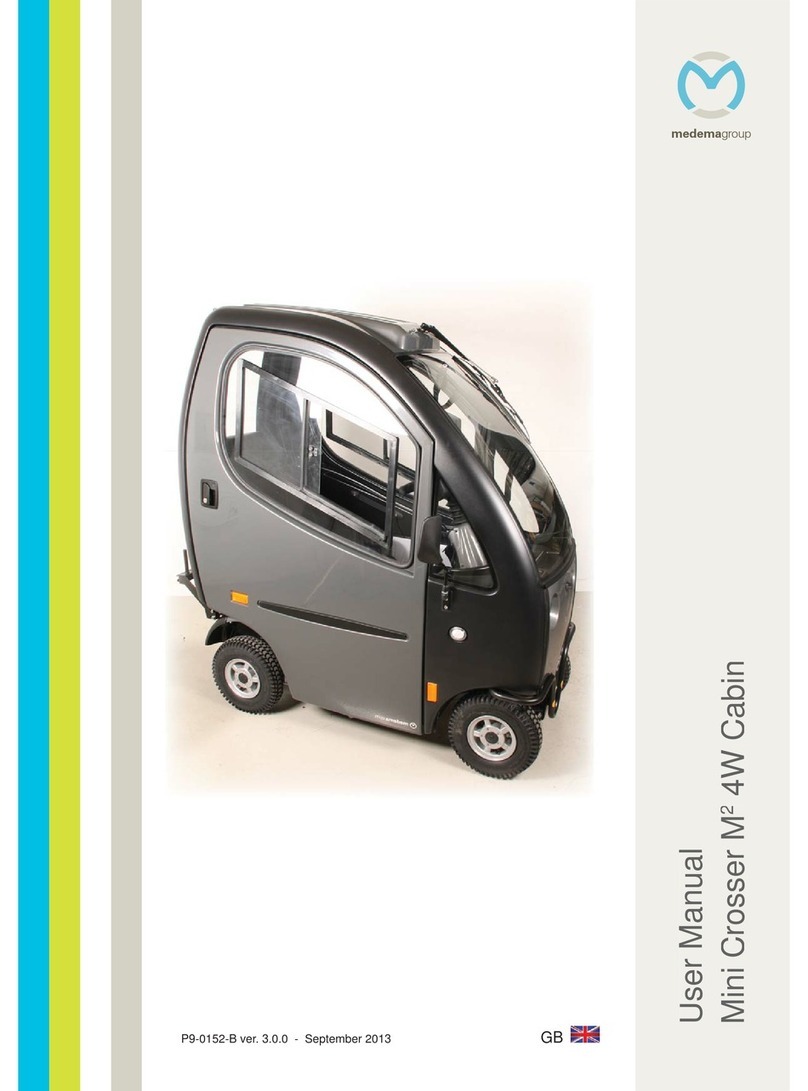
Medema
Medema Mini Crosses M2 4W Cabin User manual
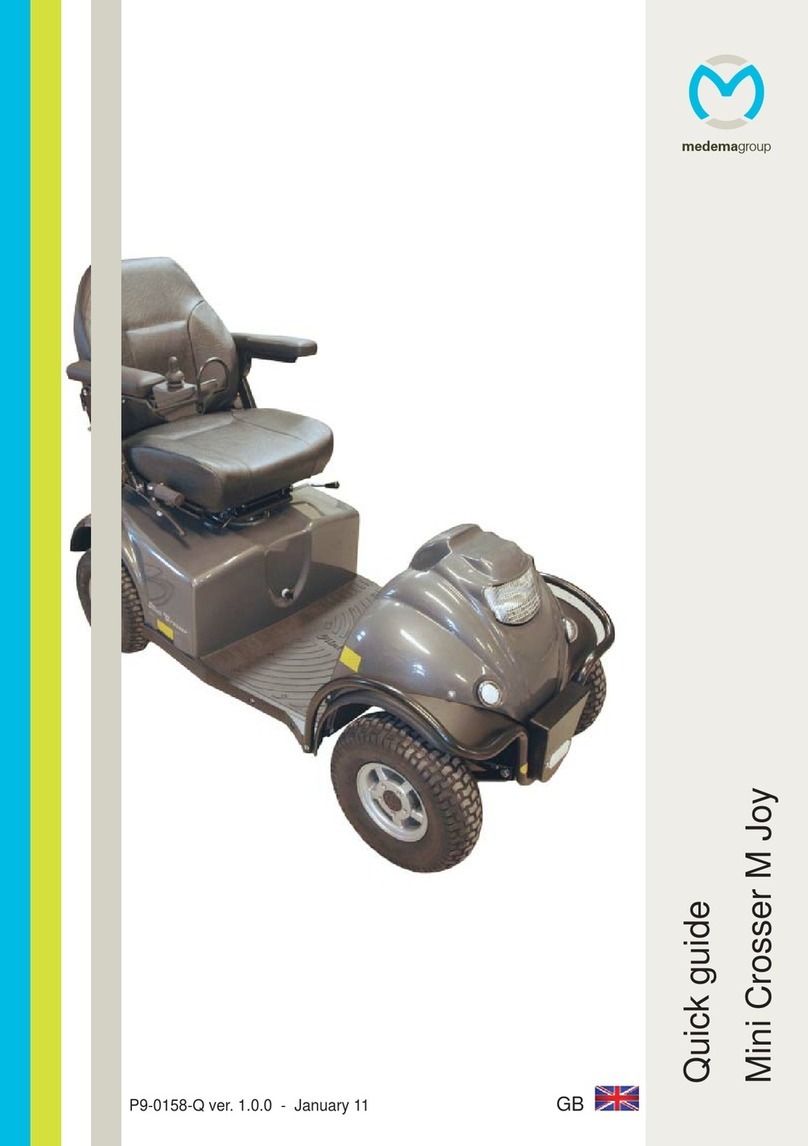
Medema
Medema M Joy User manual
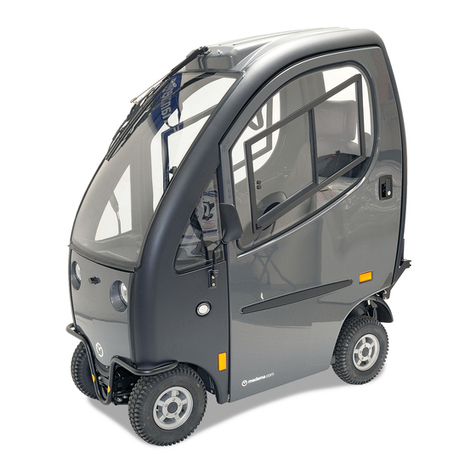
Medema
Medema Mini Crosser M1 Cabin User manual
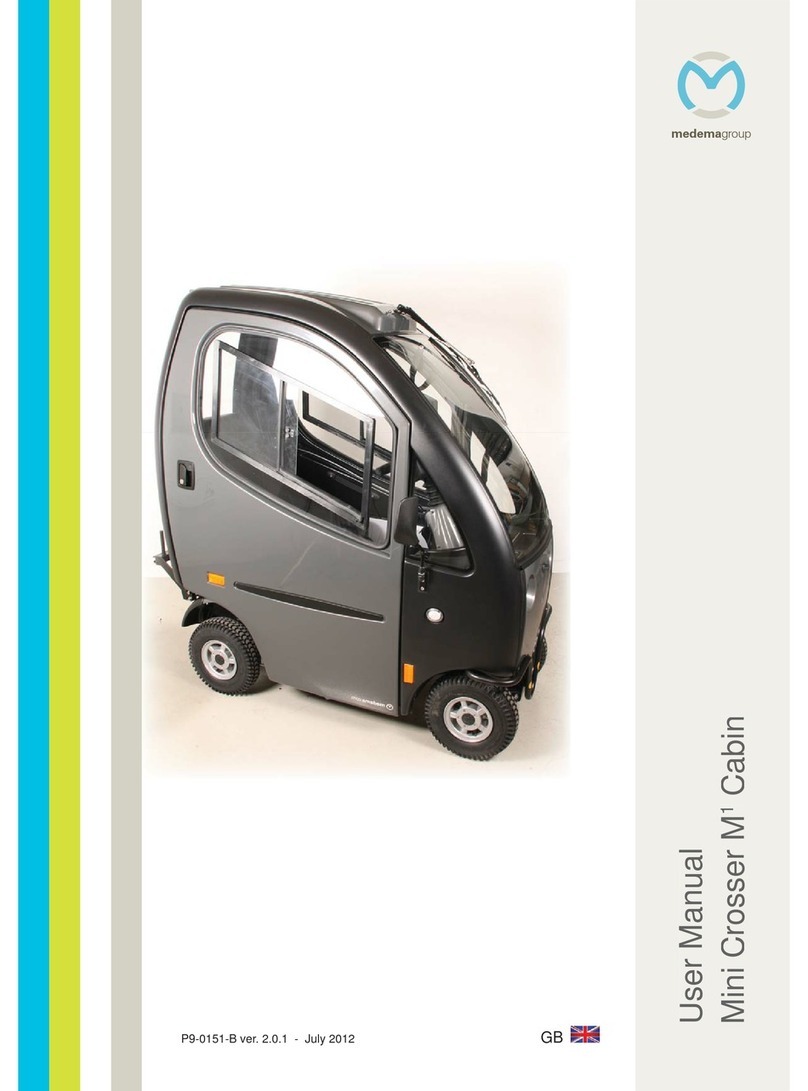
Medema
Medema Mini Crosser M1 User manual
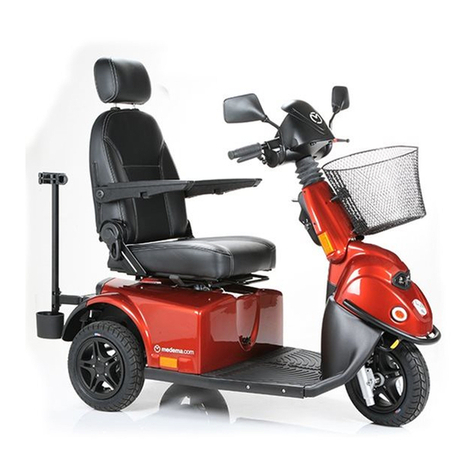
Medema
Medema Mini Crosser X1 User manual
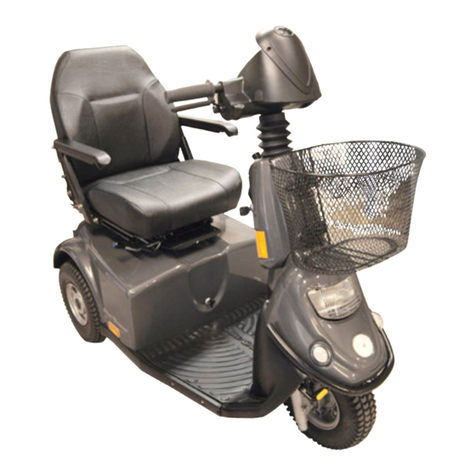
Medema
Medema Mini Crosser M2 User manual

